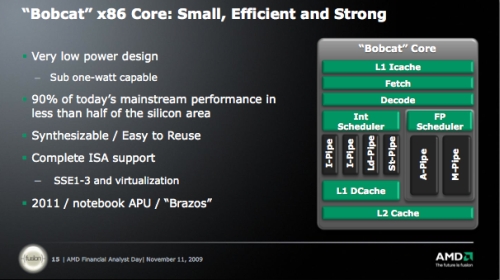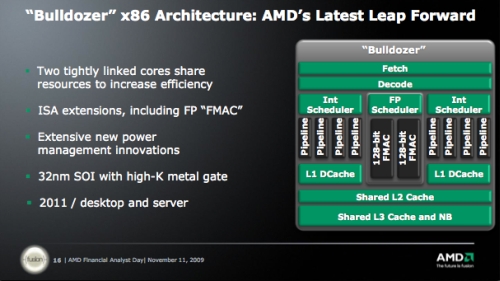Justin
Posts: 914 +0
Though AMD has taken a beating from Intel in the past few years, the Sunnyvale-based chipmaker has trekked onward. While people speculate about AMD "losing" in the CPU market, the company is still pouring a lot of resources into research and development -- and we're about to see the fruits of their labor. At a financial analyst day event, AMD unveiled a roadmap that details two new processor architectures, dubbed "Bobcat" and "Bulldozer".
Both architectures are x86-based, but represent significant changes in how AMD is designing processors. Bobcat is AMD's new mobile platform and Bulldozer is focused on servers, each branch away from traditional designs to cater to their specific markets. Bobcat, for instance, will feature extremely low power requirements, with thermal envelopes under a single watt.

Without revealing too much information, the company specified that performance was not sacrificed as it often must be on most ultra-low power processors, claiming it is within 90% of modern mobile processor range. Clock speeds, pipeline depth, specific instruction support and other details were left out -- aside from mentioning that they will fully support SSE1, 2 and 3.
Continue reading after the jump.
Initially based on a 32nm process, the new Bulldozer chips will feature multiple sets of pipelines that share a single 128bit FPU, as well as L2 and L3 cache. It's speculated the CPU will be capable of executing a minimum of four instructions per cycle, and quite possibly double that. Unfortunately AMD has been very light on specific details, and were more interested in announcing timeframes than design specifics.

The new CPUs should appear in 2011 -- which gives Intel ample time to adjust their own lineup, so there's no real way to determine how they well respond. AMD made huge waves when they pushed out the (arguably) revolutionary X86-64 instruction set in the K8 architecture. It was one of the few times that Intel ended up following AMD, and marked a point at which AMD held a respectable command of the CPU performance market.
That hasn't been the case for some time, and clearly AMD thinks that radical engineering is the solution. Though it's more than a year away, it's still very exciting stuff.